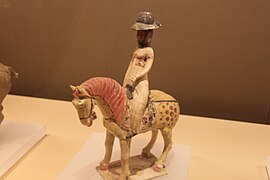| Humao | |||||||
|---|---|---|---|---|---|---|---|
 A female rider wearing the humao (veil-less hat) and a form of hood (mili) A female rider wearing the humao (veil-less hat) and a form of hood (mili) | |||||||
| Chinese | 胡帽 | ||||||
| Literal meaning | Barbarian hat | ||||||
| |||||||
Humao (Chinese: 胡帽; lit. 'Barbarian hat') is a type of brim hat which was used in the Tang dynasty by both Chinese men and women when horse-riding. Women of all social ranks (ranging from palace ladies to commoners) wore humao when horse-riding since the beginning of the Kaiyuan period (713–741 AD), during the Mid-Tang dynasty. The humao was a type of veil-less hat (which contrasted to the weimao); therefore, it allowed for the faces and hair to be exposed.
Gallery
Similar items
See also
References
- Stepanov, T︠S︡vetelin (2010). The Bulgars and the steppe empire in the early Middle Ages : the problem of the others. Leiden : Brill. ISBN 978-90-474-4452-7. OCLC 695988846.
- ^ China : dawn of a golden age, 200-750 AD. James C. Y. Watt, Prudence Oliver Harper, Metropolitan Museum of Art. New York: Metropolitan Museum of Art. 2004. ISBN 1-58839-126-4. OCLC 55846475.
{{cite book}}: CS1 maint: others (link) - ^ Xu, Zhuoyun (2012). China : a new cultural history. Timothy Danforth Baker, Michael S. Duke. New York: Columbia University Press. ISBN 978-0-231-15920-3. OCLC 730906510.
| Traditional Han Chinese clothing | |||||||||||||||||||
|---|---|---|---|---|---|---|---|---|---|---|---|---|---|---|---|---|---|---|---|
| Characteristics |
| ||||||||||||||||||
| Garments |
| ||||||||||||||||||
| Headwear (list) |
| ||||||||||||||||||
| Footwear (list) | |||||||||||||||||||
| Accessories (list) |
| ||||||||||||||||||
| Influenced clothing |
| ||||||||||||||||||
| Cosmetics | |||||||||||||||||||
This article related to the history of China is a stub. You can help Misplaced Pages by expanding it. |
This clothing-related article is a stub. You can help Misplaced Pages by expanding it. |


